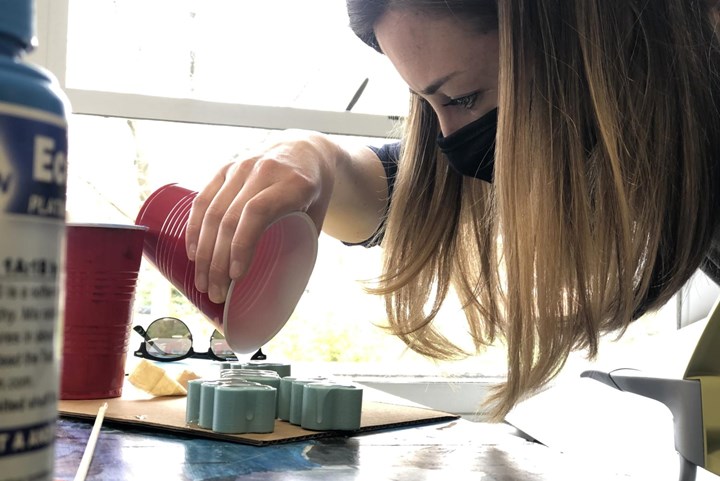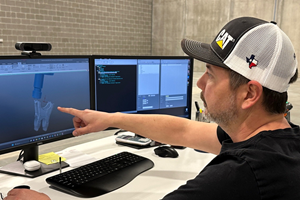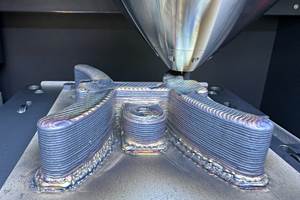Is Additive Freeing Designers or Aiding Manufacturers?
A shift toward maximizing AM benefits for manufacturers, not only product designers and process engineers, will help AM take off.
Share









Jessica Menold, assistant professor of engineering design, manufactures silicone earbuds for single-use stethoscopes using silicone rubber molds formed from 3D printed earbuds. Photo credit: Christian Baum. All rights reserved.
I hope you are sitting down for this one: I have recently come to the conclusion that the people advancing and promoting additive manufacturing (AM), including me, may have been marketing it wrong and even marketing it to the wrong people.
Yes, AM has successfully solved the “prototyping problem” and has shown its strength during the pandemic, but AM is most often advertised, marketed and sold touting the benefits of “free complexity,” design freedom, material freedom, lightweighting, bio-inspired design and so on. These are all design problems, not manufacturing problems. The AM community has been so busy freeing the designers that we forgot about aiding manufacturers. As a result, the primary channels that have emerged target product development and engineering — not the process engineers, machining professionals and myriad other people working in a manufacturing enterprise. As my cartoon namesake father would say, “D’oh!”
I’m equally guilty of this and have unfortunately been perpetuating it with my own students for nearly 25 years — sorry! My background is mechanical engineering and product design, and my views and perspectives on AM have been shaped accordingly since 3D printing technology hit the market when I was an undergraduate in engineering. Consequently, my columns have mainly focused on all of the design (and material) benefits of AM, explaining the different AM processes and their benefits, and sharing the challenges with post-processing, high costs, need for new AM standards and so on. I’ve shared insights from my own AM experiences, adventures and failures, and I have tried my best to identify ways that traditional manufacturing experts can help AM in hopes of welcoming them into AM and dispelling any fears of using it. Heck, my very first column was a plea to the machining professionals to help AM solve all of its problems.
But a lot has changed over the past decade, particularly with metal AM technology. I have been fortunate to be at the forefront of a lot of this development while serving as co-director of a leading AM research facility at Penn State, CIMP-3D. Needless to say, I have learned a ton about things I previously had little knowledge of — things I didn’t even know to ask or look for. I have also been fortunate to be part of The Barnes Global Advisors for five years now, and it has been eye-opening to work with a team of industry experts that have actually designed, manufactured, qualified, certified and flown metal AM parts. We frequently joke that Chelsea Cummings is the “jaded process engineer” when she and I coteach, but she has qualified an AM part for aerospace — not me! I learn something new from her every time we talk.
Most recently, I was fortunate to be able to lead Penn State’s response to address shortages of personal protective equipment (PPE) and other supplies for healthcare professionals. I have written about my Manufacturing And Sterilization for COVID19 (MASC) effort often, but one of the biggest “lessons learned” for me in running a team of 400 people was how far AM still needs to come to be “industrialized” in many cases.
The MASC team grew from my network of AM and 3D printing friends and colleagues, first at Penn State, then at Hershey Medical Center, then across the Commonwealth of Pennsylvania. We used AM in every way that you can imagine and have read about, and in the end, the best uses for AM come from aiding manufacturing, not maximizing design freedom or exploiting a lattice structure. Sure, we did that, but only to save material to reduce costs and shorten print time to make an AM solution viable. Unfortunately, nine times out of 10, AM wasn’t the best, fastest, cheapest way to manufacture a part. Not even close.
There were wins though. AM gained immediate traction within MASC when it helped 3D print fixtures and tooling to aid production and assembly, made molds to pour silicone earbuds for single-use stethoscopes (see image) and consolidated multipiece assemblies into a single AM part to save labor costs and reduce takt time.
AM for injection molded tooling? Maybe, but there is a high risk and high cost associated despite being faster. AM to mass produce 3D printed face shields and filtration masks? Too expensive and too slow unless production is already at scale. AM for replacement parts and spares? Maybe, but only if the materials are compatible, sterilizable and adhere to FDA cGMP regulations. Needless to say, I learned a lot as I tried to put my AM knowledge into action, and it has reframed my thinking. Combine that with all the online AM training I’ve been presenting, and my entire mindset about what we teach has shifted. Likewise, so has my column.
If you work in production, I need your help. What are some of the primary “pain points” you experience in manufacturing? Proponents of AM talk about production aids, fixtures and the like, but what do you really wish you had next to you on the mill or lathe? On the factory floor? On the assembly line? In the paint booth? I currently have 10 ‘buckets’ in mind for how AM might aid manufacturing, and I hope to find real-life examples to both corroborate and expand my list.
Feel free to connect on LinkedIn or via email at Penn State. And don’t worry, I won’t publicly share anything you send without your permission. Meanwhile, let’s start talking about how AM can aid manufacturers, not just free those product designers and engineers.
Related Content
Digital Transparency in Machining Key to Multi-Site Additive Manufacturing
Cumberland Additive’s CNC programmer in Pennsylvania spends most of his time writing programs for machine tools in Texas.
Read MoreChuck Jaws Achieve 77% Weight Reduction Through 3D Printing
Alpha Precision Group (APG) has developed an innovative workholding design for faster spindle speeds through sinter-based additive manufacturing.
Read MoreHow to Meet Aerospace’s Material Challenges and More at IMTS
Succeeding in aerospace manufacturing requires high-performing processes paired with high-performance machine tools. IMTS can help you find both.
Read MorePush-Button DED System Aims for Machine Shop Workflow in Metal Additive Manufacturing
Meltio M600 metal 3D printer employs probing, quick-change workholding and wire material stock to permit production in coordination with CNC machines.
Read MoreRead Next
5 Rules of Thumb for Buying CNC Machine Tools
Use these tips to carefully plan your machine tool purchases and to avoid regretting your decision later.
Read MoreRegistration Now Open for the Precision Machining Technology Show (PMTS) 2025
The precision machining industry’s premier event returns to Cleveland, OH, April 1-3.
Read MoreBuilding Out a Foundation for Student Machinists
Autodesk and Haas have teamed up to produce an introductory course for students that covers the basics of CAD, CAM and CNC while providing them with a portfolio part.
Read More


















.png;maxWidth=150)

















.jpg;maxWidth=300;quality=90)




.jpg;maxWidth=300;quality=90)







